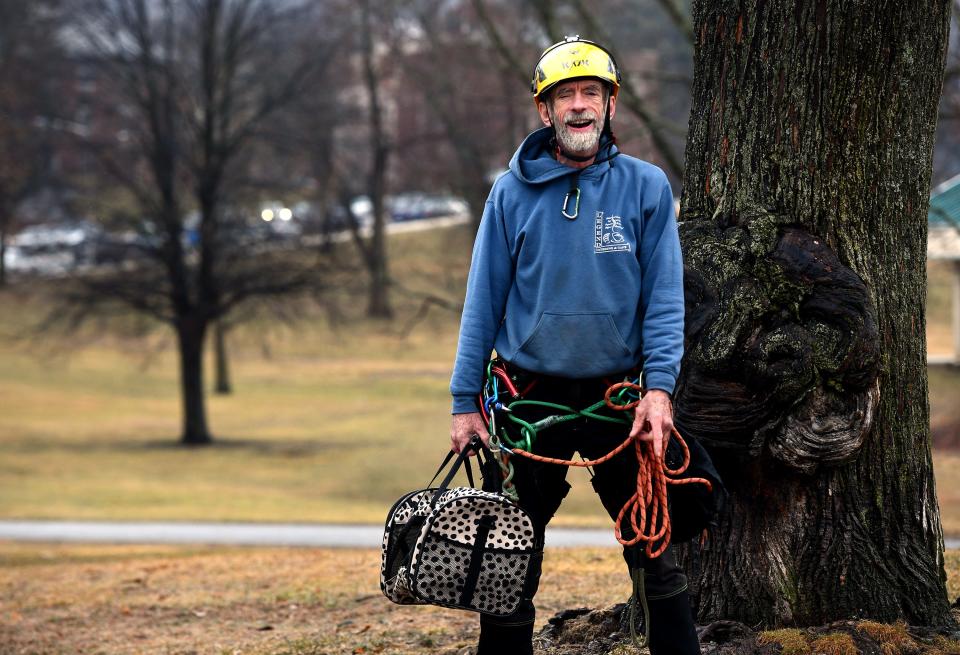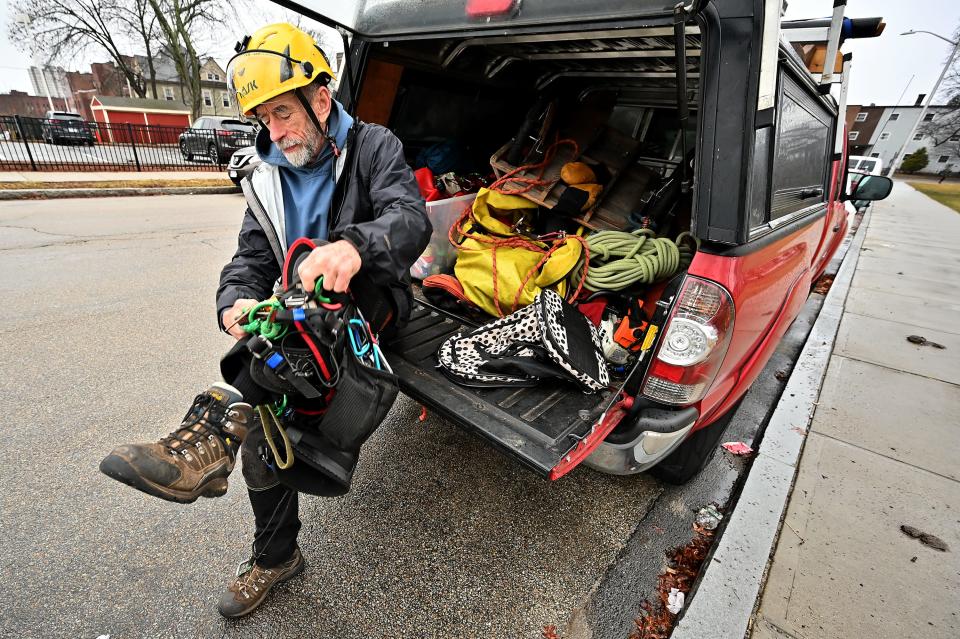Meet the 'cat whisperer': Mass. man's job is rescuing frightened felines
The cat has been up in the tree for close to four weeks. With the 90-degree summer weather, it’s hungry, dehydrated and agitated. Andrew Joslin knows that time is running out.

Donning his rope and harness, the professional cat rescuer ascends the tree almost 85 feet above the ground. When he sees the animal draped over the branch and unmoving, he fears the worst and moves quickly. Only for the very much alive cat to be quicker, delivering a painful bite before running down the branch.
“The fang went right through my thumbnail,” recalled Joslin. Despite an injured hand, the ornery feline was rescued soon after, brought back to Earth and the arms of a very concerned owner.
It was in the summer of 2021 in Fitchburg and to this day is the longest period a cat has been in a tree during Joslin’s almost 20-year career.
Come for the birds, stay for the cats
Joslin began technical climbing, using a rope and harness, as a hobby to better assist his bird photography. Certain species can only be found in the forest canopy. “I realized if I really want to photograph these birds I need to get up there,” he said.
While he was living in Jamaica Plain, a friend of a friend’s cat was stuck in a tree. Knowing he was an avid tree climber, the friend asked Joslin for help.
What started as a favor to a friend has now become a vocation and Joslin, 68, has become something of a local superhero for the region’s cat owners. The reputation of the "cat whisperer," as he came to be known, spread first by word of mouth before blowing up on social media, passed along through lost pet groups and town Facebook bulletins.
“It’s a very specific niche,” said Joslin, which means his services are often in demand. “I’m starting to work on boundary issues. People call at all hours once you get known for being good at something.” Out of hundreds of rescues, Joslin estimates probably 20 to 25 of them were in Worcester County.

Luckily, not every call means a road trip, and Joslin can coach an owner on how to convince a trapped feline out of a tough spot. Monday, he had done three “remote rescues” before noon.
Listen to cats, talk to people
Though he has gained the title of cat whisperer, Joslin considers himself more accurately to be a cat listener, properly reading the cat’s behavioral cues — flattened ears, pacing — and acting accordingly.
“A cat’s behavior in trees is very different from their behavior on the ground,” said Joslin. In trees, a cat is feeling trapped and likely already stressed, even before factoring in different personalities.
While Joslin is there to help, the cat in question may not see it that way. “From the cat’s point of view, I’m essentially a predator,” he said. Quiet, soothing tones are crucial to make sure the animal doesn’t bolt.
Age is another variable that can affect how he approaches a rescue, with younger animals usually being easier. “Any cat under 1 year old is no problem,” he said. Being young and inexperienced, they are easier to scoop up by the scruff of the neck, known as scruffing. “Older cats are harder to scruff,” he said.
Despite the unpredictable nature of the actual rescues, Joslin holds that managing people is the most difficult part of the job. In many cases, the cats are not the only ones in need of calming tones.
“It can be really hard to talk to people when they’re like this,” he said, especially when his advice to a distraught owner is to walk away. Cats are not in as much immediate danger in a tree as owners think. Joslin said there is almost no chance of a predator such as a hawk or owl taking a cat out of a tree, neither of which are in the habit of taking prey from trees, with heat loss and dehydration actually the biggest threats.
This means it’s important to monitor the cat but not stand around the base of the tree, he said — difficult when the cat in question is crying and mewling, but then it’s all the more important for the owner to stay out of sight.
“The cat is crying because it sees you and it’s thinking, ‘You dumb human. Feed me. Help me. Do what you always do,’” said Joslin. Moving away allows the cat to calm down and save energy. In the winter, any time spent making noise is time it could have been curled up to conserve heat, and in the summer, vocalizing will only make it thirsty.
In the Fitchburg case, the cat was severely dehydrated and only survived as long as it did because it was rained on a couple of times, providing some much-needed water. “An owner might think it’s more urgent (to get a cat down) because it’s going to rain, but it can actually be a good thing,” said Joslin.
Why do cats get stuck?
Few things have more forward momentum than a fleeing feline. “All cats have four-wheel drive when going forward,” said Joslin, and will run up the nearest thing when in danger, be it a pole, garage or a tree, and will keep going until they hit the first branch, whether it is 10 feet or 40 feet off the ground.
Some cats can ease themselves down the trunk backwards before safely dropping to the ground, known as downclimbing, but not all. From his own anecdotal observations, Joslin believes cats learn this skill as kittens while playing and it becomes more difficult as they get older.
Naturally, that is more often the case with kittens raised in a more outdoors environment, so an indoor cat is more likely to get stuck. Joslin's own experience supports the theory, as he said he has never come across a primarily indoor cat that could downclimb.
No cat left behind
Joslin charges $200 for a basic rescue, which means a climb and retrieval. If the situation gets more complicated, like if the cat jumps to another tree, or other unusual factors, he simply says, “We’ll talk.”
How much is added to the cost depends on those factors, “but I don’t leave cats in trees,” he said. The important thing to remember, he said, is that owners and cats have their own schedules and they are unlikely to overlap to a meaningful degree.
“Owners are on their time and cats are on their time,” said Joslin.
This article originally appeared on Telegram & Gazette: cat whisperer rescues kitties trapped in high places

